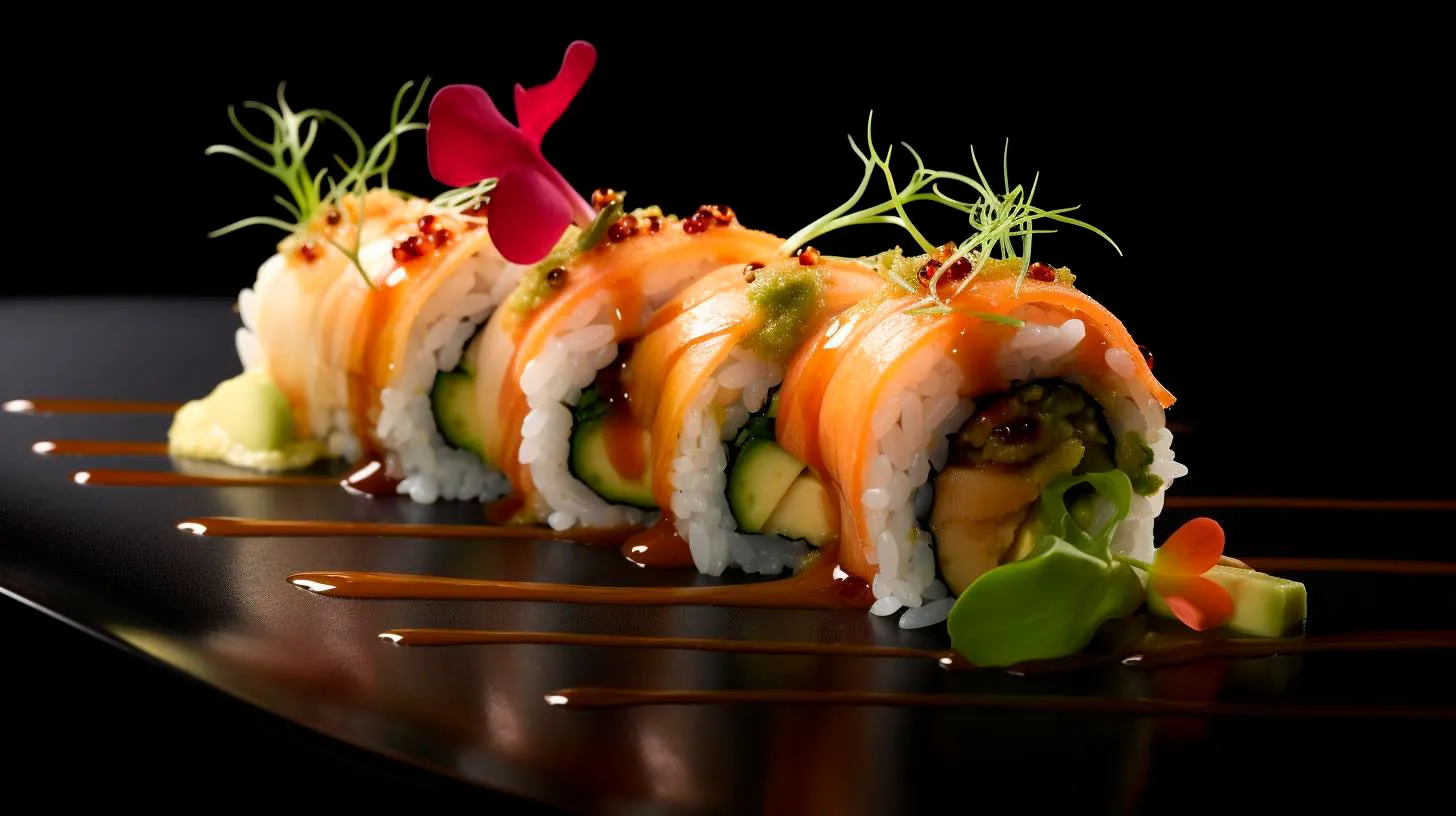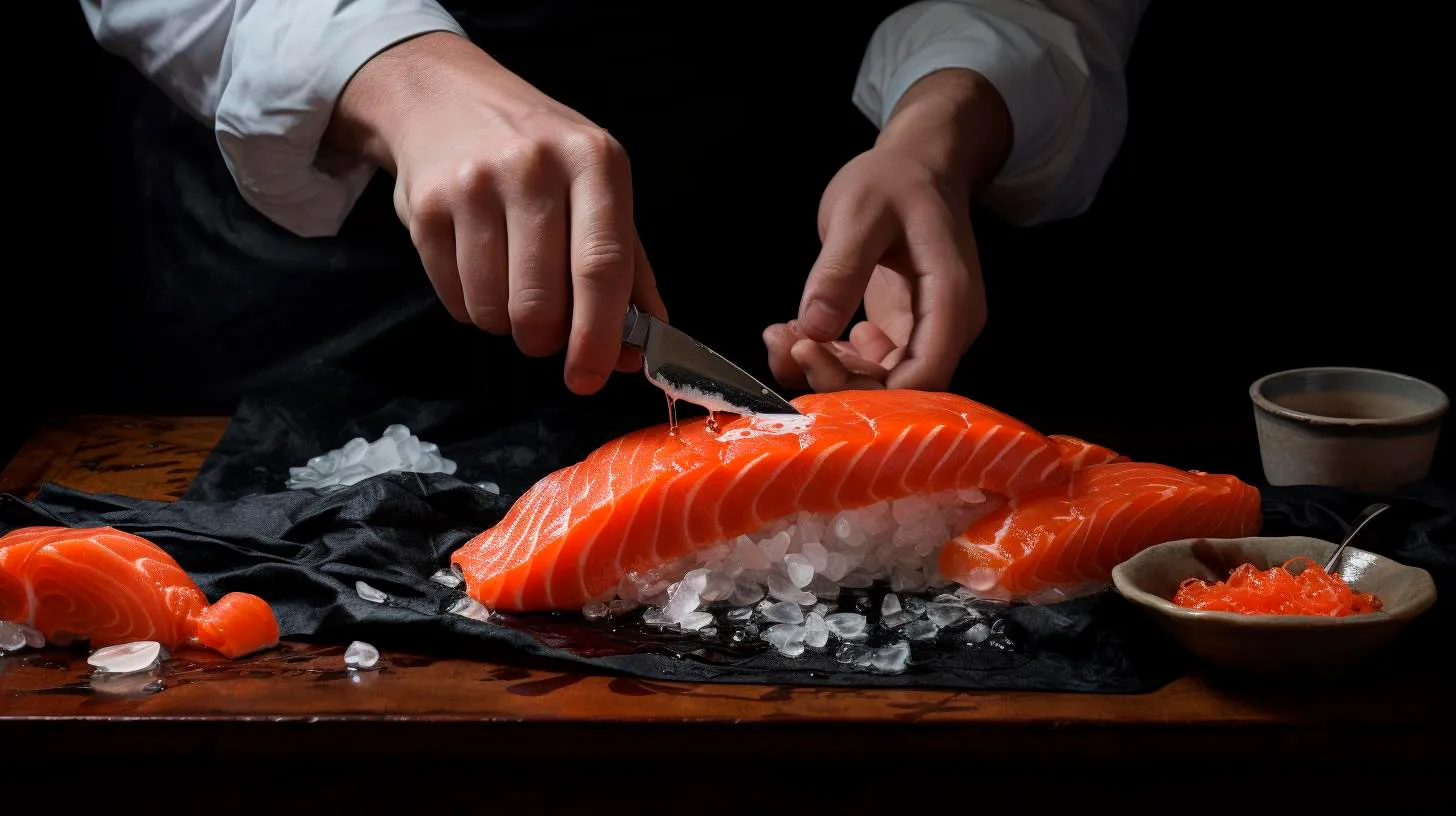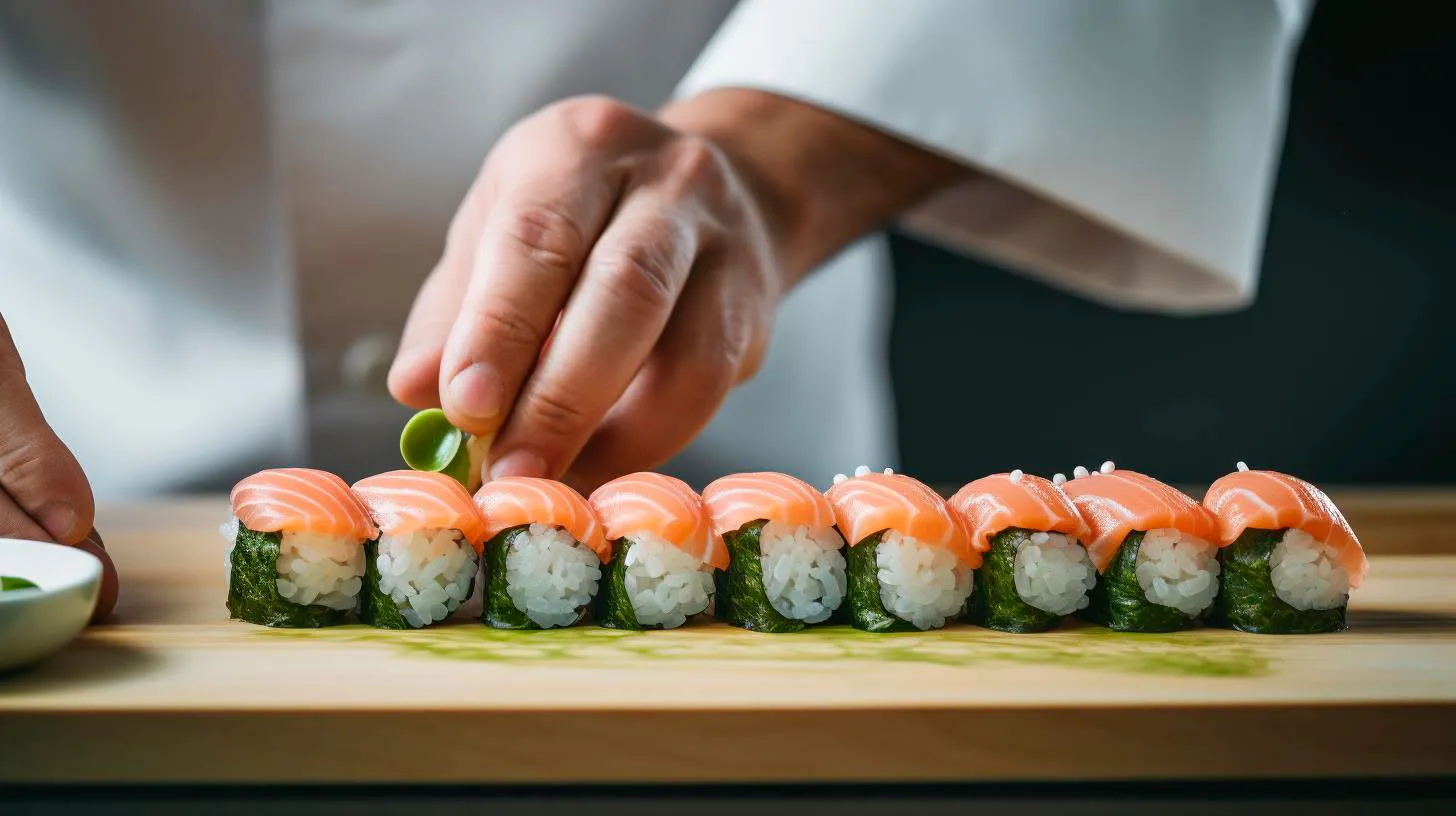Paying Homage through Sushi: Unveiling Traditional Japanese Flavors and Techniques
Join us as we dive into the world of sushi, paying homage to its origins and exploring the unique features that make it a culinary masterpiece.
The History of Sushi
Sushi, believe it or not, dates back to the 2nd century in Southeast Asia. It originally began as a method of preserving fish by fermenting it with rice, which was then discarded. Over time, this preservation technique evolved, and the rice was no longer thrown away. Instead, it became an integral part of the dish, leading to the creation of what we now know as sushi.
During the 8th century, sushi made its way to Japan, where it underwent further transformations. The Japanese began using vinegar to ferment the rice, giving it a distinct tangy flavor. The sushi we enjoy today, known as Edomae sushi, was popularized in the 19th century in Tokyo. This style is characterized by using fresh, locally sourced ingredients served atop bite-sized vinegared rice.
The Art of Sushi Making
Making sushi is a meticulous process that requires years of training to perfect. Every step is essential, from selecting the freshest fish to mastering the knife skills needed to create thin, precise slices. The chef’s techniques and attention to detail are what separate an exceptional sushi experience from an ordinary one.
Key Takeaways:
- Sushi originated in Southeast Asia as a method of preserving fish with rice.
- Japanese sushi, known as Edomae sushi, gained popularity in the 19th century.
- Sushi making is an art that requires precision and expertise.
The Flavors of Sushi
When it comes to sushi, the flavors are as diverse as the variety of fish and other ingredients used. The delicate balance of sweet, savory, tangy, and umami is what sets sushi apart. Let’s explore some of the key flavors you can expect when indulging in this Japanese delicacy.
Vinegar-infused Rice
One of the defining characteristics of sushi is its vinegared rice. The rice is cooked with a mixture of rice vinegar, sugar, and salt, giving it a slightly tangy and sweet flavor. This vinegar-infused rice acts as the perfect base for showcasing the other ingredients, providing a refreshing and appetizing element to each bite.
Fresh Seafood
From succulent salmon to buttery tuna, the assortment of fish options in sushi is truly remarkable. The choice of seafood depends on availability and seasonality, ensuring that only the freshest catches are used. The pristine quality of the fish shines through, delivering a burst of natural flavors with each bite.
Wasabi and Soy Sauce
Wasabi, a pungent green condiment, and soy sauce are the classic accompaniments to sushi. Wasabi adds a spicy kick, while soy sauce provides a salty umami flavor. When used in moderation, these condiments enhance the overall taste of sushi, complementing the flavors without overpowering them.
Key Takeaways:
- Sushi offers a delightful combination of sweet, savory, tangy, and umami flavors.
- Vinegared rice provides a refreshing and appetizing base for sushi.
- Fresh seafood plays a crucial role in delivering natural and diverse flavors.
- Wasabi and soy sauce add a kick and enhance the taste of sushi.
The Advantages and Unique Features of Sushi
Sushi is not only a culinary delight but also offers numerous advantages that make it stand out from other cuisines. Let’s explore some of the unique features and benefits of indulging in this delectable Japanese dish.
Health Benefits
Sushi is packed with nutritional benefits. Fish, a primary component of sushi, is an excellent source of lean protein, omega-3 fatty acids, and vitamins such as D and B12. Additionally, the seaweed used in sushi contains minerals like iodine and iron, contributing to a well-balanced and nutritious meal.
Variety for All Palates
Whether you are a seafood lover or prefer vegetarian options, sushi caters to a wide range of dietary preferences. From classic salmon nigiri to vegetable rolls, there is something for everyone. Sushi offers a variety of flavors and textures, allowing individuals to savor their preferred combinations with each bite.
Cultural Experience
Sushi is more than just a meal; it is a cultural experience. Each sushi piece represents the craftsmanship and dedication of the chef, paying homage to centuries-old traditions. Dining on sushi provides an opportunity to immerse oneself in Japanese culture, appreciating the precision and artistic presentation that goes into each dish.
Key Takeaways:
- Sushi provides a range of health benefits, including lean protein and essential vitamins.
- Vegetarian options and diverse flavor combinations make sushi suitable for various dietary preferences.
- Sushi offers a cultural experience, immersing diners in Japanese traditions.
In conclusion, sushi transcends mere food; it is an art form that encapsulates the spirit of Japan. From its humble beginnings to its present-day global popularity, sushi has captivated people around the world with its flavors, techniques, and cultural significance. Whether you are a seasoned sushi lover or a curious first-time diner, exploring this traditional Japanese cuisine is a delightful journey that will leave you craving for more.
Honoring Samurai Legacy: Exploring the Artistry and Philosophy of Sushi Making
Much like the samurai warriors of ancient Japan, sushi chefs demonstrate discipline, precision, and an unwavering commitment to perfection. In this article, we delve into the artistry and philosophy behind sushi-making, highlighting its key attributes and shedding light on the deep-rooted traditions it represents.
Sushi: The Essence of Artistry
Sushi, in its simplest form, is a dish crafted from delicately seasoned rice combined with a variety of toppings, most commonly fresh seafood. However, what sets sushi apart is the meticulous attention to detail involved in its creation. It is a true work of art that reflects the skill and creativity of the sushi chef. Here are some fascinating aspects that highlight the artistry of sushi-making:
- Presentation: Sushi is not only about taste; it is a visual delight. The chef carefully arranges the ingredients, paying attention to color, texture, and balance.
- Knife Skills: Sushi chefs undergo years of training to master the art of cutting ingredients with precision. Each slice is meticulously crafted to ensure the perfect texture and flavor.
- Garnishes: The chef adds complimentary garnishes such as wasabi, pickled ginger, or decorative edible flowers to enhance both the flavor and aesthetics of the dish.
The Philosophy of Sushi-Making: Balance and Respect
Sushi-making goes beyond mere culinary expertise; it embodies a philosophy that revolves around balance, respect, and a deep connection with nature. Here are some key facets of the sushi-making philosophy:
- Balance: Sushi is all about achieving a harmonious balance of flavors, textures, and colors. Each ingredient is thoughtfully selected to create a well-rounded experience for the diner.
- Respect for Ingredients: Sushi chefs deeply respect the quality and freshness of their ingredients. They source seafood directly from trusted suppliers to ensure the utmost excellence.
- Minimalism: Sushi celebrates the beauty of simplicity. The philosophy emphasizes the use of minimal ingredients, allowing each component to shine individually.
The Samurai Connection
Surprisingly, the art of sushi-making shares a profound connection with the esteemed samurai warriors of feudal Japan. Like the samurai, sushi chefs embrace a strict code of conduct and adhere to the principles of discipline, respect, and lifelong learning. Here are some remarkable parallels:
- Discipline: Sushi chefs undergo arduous training, resembling the rigorous discipline that samurai warriors endured in their quest for perfection.
- Precision: The precision and attention to detail necessary in sushi-making mirror the meticulousness required in the samurai’s swordcraft.
- Respect for Craft: Both sushi chefs and samurai warriors consider their respective crafts as sacred traditions, passing down their knowledge to the next generation.
Key Takeaways from the Samurai Legacy in Sushi Making
Exploring the artistry and philosophy of sushi-making reveals valuable lessons that can be applied to various aspects of life. Here are some key takeaways:
- Embrace Discipline: Just like sushi chefs and samurai warriors, success in any endeavor requires discipline, practice, and a determination to continuously improve.
- Value Balance: Finding balance in life is essential. Whether it’s achieving harmony in flavors or maintaining equilibrium between work and personal life, balance promotes overall well-being.
- Show Respect: Respect for oneself, others, and the traditions we follow leads to a greater sense of purpose and fosters healthy relationships.
- Attention to Detail: By paying attention to the intricacies of any task, we elevate it from ordinary to extraordinary.
As you savor every piece of sushi, remember the incredible history and legacy it carries. Sushi-making is not just about creating a delectable meal; it is a journey that celebrates tradition, artistry, and the enduring spirit of the samurai.
Sushi as a Cultural Symbol: Celebrating Samurai Influence on Modern Culinary Excellence
This iconic Japanese dish, consisting of rice seasoned with vinegar and various ingredients such as raw fish, has captured the hearts and taste buds of people worldwide. In this article, we delve into the fascinating history of sushi and explore its enduring connection to the samurai culture, along with its journey as a global culinary sensation.
The Historical Roots of Sushi
The roots of sushi can be traced back to the 8th century, where it first emerged as a method of preserving fish in rice. During this time, sushi was a reflection of practicality rather than the refined delicacy it is known as today. Rice was used as a fermentation agent, ensuring that the fish stayed edible for longer periods. Over time, this preservation technique evolved and became more sophisticated.
During the Edo period (1603-1868), sushi transformed into the beloved cuisine we recognize today. In this era, sushi chefs began to experiment with new ingredients, refined their techniques, and focused on enhancing the visual appeal of the dish. The artful presentation of sushi became an essential aspect of its culinary experience.
The Connection to Samurai Culture
The samurai, legendary warriors of feudal Japan, played a significant role in shaping sushi’s evolution and cultural significance. Samurai warriors were known for their strict adherence to discipline, respect for tradition, and pursuit of perfection. These principles seamlessly integrated with the artistry and precision required in sushi preparation.
Samurai traditions have influenced various aspects of sushi, including its presentation, knife skills, and the emphasis on using the finest, freshest ingredients available. The attention to detail and commitment to perfecting their craft exhibited by samurai warriors translated into the meticulous preparation and presentation of sushi by skilled chefs.
The Journey of Sushi as a Global Culinary Sensation
Over the years, sushi has expanded beyond the borders of Japan and gained popularity worldwide. Its incorporation into various global cuisines and the establishment of sushi restaurants in almost every major city is a testament to its growing influence.
Key Features and Advantages:
- Health Benefits: Sushi is widely recognized as a healthy food choice due to its balanced combination of vegetables, seafood, and rice. It is low in fat, high in omega-3 fatty acids, and rich in essential nutrients.
- Artistic Presentation: Sushi is often served as an edible work of art, with vibrant colors, intricate garnishes, and meticulous plating. Its visual appeal enhances the overall dining experience.
- Flavorful Combinations: Sushi offers a wide range of flavors and textures, allowing diners to explore a variety of taste sensations in a single meal. From delicate sashimi to savory rolls, there is something to suit every palate.
- Social Dining: Sushi is often enjoyed in groups, making it a popular choice for social gatherings and family meals. The shared experience of selecting and sampling different rolls creates a sense of camaraderie and celebration.
As sushi continues to evolve, modern culinary techniques and innovations merge seamlessly with traditional practices. Chefs around the world are constantly pushing the boundaries of creativity, resulting in unique sushi creations that reflect both local flavors and global influences. From sushi burritos to fusion sushi rolls, these adaptations offer exciting options for sushi enthusiasts.
Key Takeaways
Sushi, a cultural symbol that pays homage to the samurai traditions, has transformed from a preservation technique to a globally celebrated culinary delight. Its connection to the disciplined and artful practices of the samurai resonates through its presentation, knife skills, and choice of ingredients. With its numerous health benefits, artistic appeal, and flavorful combinations, sushi has transcended cultural boundaries to become an iconic dish enjoyed by people all over the world.
Embrace the legacy of the samurai, explore the diverse flavors of sushi, and indulge in this exquisite culinary experience.
Preserving Samurai Heritage: How Sushi Reflects the Values and Traditions of Ancient Japan
In this article, we explore the rich heritage of samurai culture and how it is exemplified in the preparation and presentation of sushi.
A Glimpse into Samurai Culture
The samurai, renowned warriors of feudal Japan, were not only skilled in martial arts but also valued discipline, honor, and precise attention to detail. Their way of life, known as “Bushido,” greatly influenced the social fabric of Japan. Today, while the samurai era may have come to an end, its legacy lives on through various aspects of Japanese culture, including the remarkable art of sushi making.
Sushi: A Culinary Masterpiece
Sushi, with its minimalist yet sophisticated presentation, embodies the principles cherished by ancient samurai warriors. From the selection of ingredients to the precise knife skills needed for slicing fish, every step of sushi making requires meticulous attention to detail.
- Freshness: Just like samurai warriors, sushi chefs prioritize freshness. The raw fish used in sushi must be of the highest quality, ensuring an exceptional dining experience.
- Presentation: The visually appealing presentation of sushi is reminiscent of the samurai’s focus on aesthetics. The smooth texture of the rice, vibrant colors of the ingredients, and the clean lines of the final sushi roll showcase the artistry involved.
- Precision: Each sushi roll is meticulously crafted with precision, mirroring the meticulousness in the samurai’s swordsmanship. From the size and shape of the rice to the perfect amount of wasabi, every element is carefully measured and placed.
- Balance: Sushi is a delicate balance of flavors and textures. The harmony achieved in each bite is reminiscent of the samurai’s quest for balance in all aspects of life, including conflict resolution and personal conduct.
- Patience: Sushi making requires patience and dedication. The time-consuming process of fermenting rice, aging fish, and perfecting techniques mirrors the samurai’s perseverance and commitment to mastering their skills.
Preserving Ancient Traditions
While sushi has evolved over time, modern sushi chefs strive to maintain the spirit of samurai traditions. The emphasis on precision, freshness, and presentation ensures that the legacy of ancient Japan is preserved with every sushi roll.
The sushi counter, where skilled chefs diligently prepare each piece, has become a stage where culinary artistry and cultural heritage coexist. By upholding the values of the samurai, sushi chefs pay tribute to Japan’s illustrious past and provide a rich cultural experience for diners.
Key Takeaways
Sushi, beyond being a delicious culinary delight, serves as a tangible link to Japan’s samurai heritage. Understanding the values and traditions of the ancient samurai warriors allows us to appreciate the craftsmanship and artistry behind each piece of sushi.
- Sushi reflects the samurai’s emphasis on discipline, honor, and attention to detail.
- The selection of fresh ingredients and the precise preparation of sushi mirror samurai values.
- The visually appealing presentation and meticulous crafting of sushi rolls showcase the artistry involved.
- Sushi making involves patience, balance, and a quest for perfection, reminiscent of the samurai’s way of life.
- By preserving ancient traditions, sushi chefs honor the legacy of the samurai and provide a cultural experience for diners.
In conclusion, sushi serves as a living testament to the values and traditions of ancient Japan. The samurai’s influence is intricately woven into the preparation and presentation of this culinary masterpiece, allowing us to savor not only the flavors but also the rich heritage behind each sushi roll. So, the next time you indulge in a piece of sushi, take a moment to appreciate the samurai spirit that lives on through this iconic dish.



